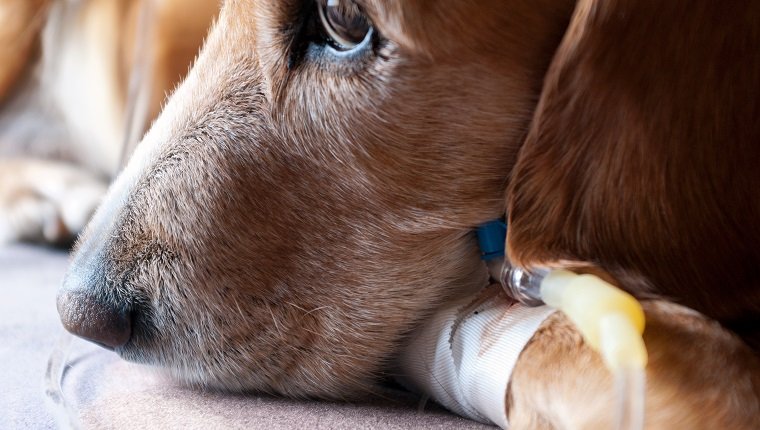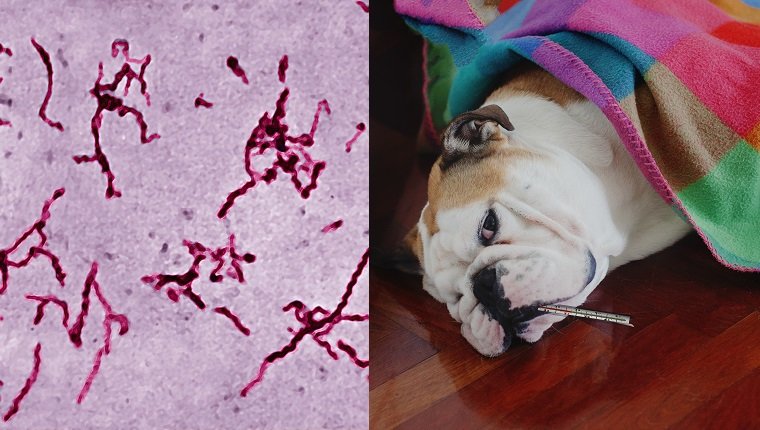Leptospirosis in dogs is a disease caused by Leptospira bacteria, which penetrates the skin and moves to the bloodstream where it can lead to infection throughout the body. Leptospira bacteria exist all over the world in water and soil, and it’s more common in places with warm climates and high rainfall.
When the bacteria infects dogs, it can spread to the liver, kidneys, central nervous system, and reproductive system. Most dogs have strong enough immune systems to fight off the infection, but some are not able to get rid of leptospirosis from all of the organs.
Even when the infection is mostly eradicated, the bacteria can remain in the kidneys and infect the urine. If the liver or kidneys are damaged by the disease, it can be fatal.
If you see the signs of leptospirosis in your dog, then you must consult your veterinarian for a proper diagnosis and treatment. Here’s what you should know about the symptoms, causes, and treatments for leptospirosis in dogs.
Symptoms Of Leptospirosis In Dogs

The symptoms of leptospirosis in dogs vary and often depend on immune system health. Some infected dogs don’t show any signs of illness, and others have mild symptoms and recover on their own.
In serious cases, severe illness develops, which can lead to death. The symptoms may also vary based on which organs are infected.
Here are some of the signs of leptospirosis in dogs:
- Fever
- Soreness or stiffness in muscles
- Difficulty moving or walking
- Shivering
- Weakness
- Loss of appetite
- Increased thirst or urination
- Difficulty urinating
- Dehydration
- Vomiting
- Diarrhea
- Jaundice
- Cough
- Difficulty breathing
- Arrhythmia
- Runny nose
- Swollen lymph nodes
- Blood in vomit, urine, stool, or saliva
- Nosebleeds
- Red spots on the gums, mucous membranes, or skin
- Edema
- Ascites
Causes Of Leptospirosis In Dogs

Leptospirosis in dogs is caused by the Leptospira bacteria, which is present in water and soil throughout the world. For this reason, dogs who drink or swim in water from lakes, rivers, or streams face greater risk, as do dogs who roam in rural areas, come into contact with infected wild life, or interact with farm animals.
Contact with infected rodents may also cause problems, and bites from infected animals can spread the disease. Ingesting infected animals or meat and tissue from contaminated dead animals is another way the disease can transmit to dogs.
Leptospirosis is more common in wet environments such as marshy or muddy places with stagnant surface water, though well-irrigated pastures in rural areas are also more likely to harbor bacteria. The disease is more prevalent in the fall season.
Infected urine or any surface that infected urine touches can spread the bacteria, as well. This includes water, food, and bedding that has urine on it. Mother dogs may pass it to their young through the placenta, and breeding sometimes spreads the infection, too.
Leptospirosis can be transmitted between species and can spread from dogs to humans, though this is not the most common means of transmission. Most people suffer exposure to Leptospira during recreational outdoor activities, usually those that involve water.
Treatments For Leptospirosis In Dogs

Treatment for leptospirosis in dogs often depends on the severity of the condition. In serious cases, vets may provide intravenous fluids to reduce dehydration and antiemitics or a feeding tube if dogs can’t keep food down. If a dog is suffering from severe hemorrhaging, they may need a blood transfusion.
Whether the infection is severe or mild, vets usually use antibiotics to fight infection. They prescribe these for use over the course of at least four weeks. If your veterinarian prescribes antibiotics, make sure to give your dog medication for the full duration of the prescription, even if symptoms improve.
Discuss side effects with your veterinarian and monitor your dog’s health as they recover. Usually the prognosis for leptospirosis is good unless there is severe organ damage.
There is a vaccine available for leptospirosis, but you should ask your veterinarian about its effectiveness and see if it is necessary for your dog before you rely on it as a means of prevention.
Has your dog ever suffered from leptospirosis? How did you help them recover? Let us know in the comments below!









